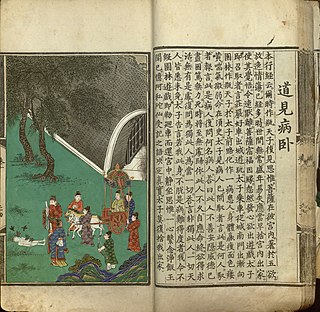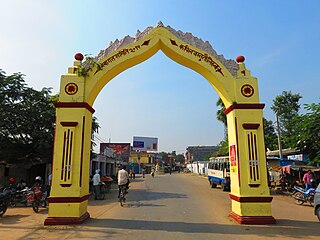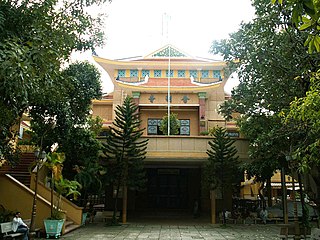
Siddhartha Gautama, most commonly referred to as the Buddha, was a wandering ascetic and religious teacher who lived in South Asia during the 6th or 5th century BCE and founded Buddhism. According to Buddhist legends, he was born in Lumbini, in what is now Nepal, to royal parents of the Shakya clan, but renounced his home life to live as a wandering ascetic. After leading a life of mendicancy, asceticism, and meditation, he attained nirvana at Bodh Gaya in what is now India. The Buddha then wandered through the lower Indo-Gangetic Plain, teaching and building a monastic order. Buddhist tradition holds he died in Kushinagar and reached parinirvana.

The four sights are four events described in the legendary account of Gautama Buddha's life which led to his realization of the impermanence and the ultimate dissatisfaction of conditioned existence. According to this legend, before these encounters Gautama Siddhartha had been confined to his palace by his father, who feared that he would become an ascetic if he came into contact with sufferings of life according to a prediction. However, his first venture out of the palace affected him deeply and made him realize the sufferings of all, and compelled him to begin his spiritual journey as a wandering ascetic, which eventually led to his enlightenment. The spiritual feeling of urgency experienced by Siddhārtha Gautama is referred to as saṃvega.
Rahul or Rāhula was the only son of Siddhārtha Gautama, and his wife, princess Yaśodharā. He is mentioned in numerous Buddhist texts, from the early period onward. Accounts about Rāhula indicate a mutual impact between Prince Siddhārtha's life and the lives of his family members. According to the Pāli tradition, Rāhula was born on the day of Prince Siddhārtha's renunciation, and was therefore named Rāhula, meaning a fetter on the path to enlightenment. According to the Mūlasarvāstivāda tradition, and numerous other later sources, however, Rāhula was only conceived on the day of Prince Siddhartha's renunciation, and was born six years later, when Prince Siddhārtha became enlightened as the Buddha. This long gestation period was explained by bad karma from previous lives of both Yaśodharā and of Rāhula himself, although more naturalistic reasons are also given. As a result of the late birth, Yaśodharā needed to prove that Rāhula was really Prince Siddhārtha's son, which she eventually did successfully by an act of truth. Historian H.W. Schumann has argued that Prince Siddhārtha conceived Rāhula and waited for his birth, to be able to leave the palace with the king and queen's permission, but Orientalist Noël Péri considered it more likely that Rāhula was born after Prince Siddhārtha left his palace.

Śuddhodana, meaning "he who grows pure rice," was the father of Siddhartha Gautama, better known as the Buddha. He was a leader of the Shakya, who lived in an oligarchic republic, with their capital at Kapilavastu.

Maya, also known as Mahāmāyā and Māyādevī, was the queen of Shakya and the birth mother of Gautama Buddha, the sage on whose teachings Buddhism was founded. She was the wife of Śuddhodana, the king of the Shakya kingdom. She was sister of Mahāpajāpatī Gotamī, the first Buddhist nun ordained by the Buddha.

Kapilvastu is a municipality and administrative center of Kapilvastu District in Lumbini Province of southern Nepal. The municipality is located roughly 25 kilometres (16 mi) to the south-west of Lumbini, a UNESCO World Heritage Site and the birthplace of Gautama Buddha.
Channa - The Divine Charioteer was a royal servant and head charioteer of Prince Siddhartha, who was to become the Buddha. Channa later became a disciple of the Buddha and achieved arahantship, as is described in the 78th verse of the Dhammapada.
The Anoma was a river in Majjhimadesa of ancient India. According to Buddhist tradition it was situated near Kapilavastu, and was crossed by Prince Siddhartha where he renounced the world before becoming the Buddha by cutting off his hair, abandoning his royal dress and exchanging it for the robes of an ascetic.

Kaundinya, also known as Ājñātakauṇḍinya, Pali: Añña Koṇḍañña), was one of the first five Buddhist monks (Pancavaggiya), disciple of Gautama Buddha and the first to attain the fruit of Arahant. He lived during the 5th century BCE in what are now Uttar Pradesh and Bihar, India. According to traditional accounts, at the time of Gautama Buddha's birth, he predicted his future destination as an enlightened teacher. Kaundinya Gotra is Hindu Gotra or clan name, named after the rishi Kaundinya.

Assaji was one of the first five arahants of Gautama Buddha. He is known for his conversion of Sariputta and Mahamoggallana, the Buddha's two chief male disciples, counterparts to the nuns Khema and Uppalavanna, the chief female disciples. He lived in what is now Uttar Pradesh and Bihar in northern India, during the 6th century BCE.
Anuruddha was one of the ten principal disciples and a cousin of Gautama Buddha.

The Xá Lợi Pagoda is the largest pagoda in Hồ Chí Minh City, Vietnam. It was built in 1956 and was the headquarters of Buddhism in South Vietnam. The pagoda is located in District 3, Hồ Chí Minh City and lies on a plot of 5000 square metres. The name Xá Lợi is the Vietnamese translation for śarīra, a term used for relics of Buddhists.

Princess Sundarī Nandā of Shakya, also known simply as Sundarī, was the daughter of King Suddhodana and Queen Mahapajapati Gotami. She was the half-sister of Siddhartha Gautama, who later became a Buddha. She became a nun after the enlightenment of her half-brother and became an arhat. She was the foremost among bhikkhunis in the practice of jhana. She lived during the 6th century BCE in what is now Bihar and Uttar Pradesh in India.
The Buddha was born into a noble family in Lumbini in 563 BCE as per historical events and 624 BCE according to Buddhist tradition. He was called Siddhartha Gautama in his childhood. His father was king Śuddhodana, leader of the Shakya clan in what was the growing state of Kosala, and his mother was queen Maya. According to Buddhist legends, the baby exhibited the marks of a great man. A prophecy indicated that, if the child stayed at home, he was destined to become a world ruler. If the child left home, however, he would become a universal spiritual leader. To make sure the boy would be a great king and world ruler, his father isolated him in his palace and he was raised by his mother's younger sister, Mahapajapati Gotami, after his mother died just seven days after childbirth.

Asita or Kaladevala or Kanhasiri was a hermit ascetic depicted in Buddhist sources as having lived in ancient India. He was a teacher and advisor of Suddhodana, a sage and seer, the father of the Buddha, and is best known for having predicted that prince Siddhartha of Kapilavastu would either become a great chakravartin or become a supreme religious leader; Siddhartha was later known as Gautama Buddha.

The Legend of Buddha is a 2004 Indian English-language animated film directed by Shamboo Falke. The film tells the story of Prince Siddhartha Gautama, who leaves his kingdom to become the spiritual leader, Buddha. The film was submitted for the Academy Award for Best Animated Feature at the 77th Academy Awards but was not nominated.

Carved elephant tusk depicting Buddha life stories is an intricately carved complete single tusk now exhibited at the Decorative Arts gallery, National Museum, New Delhi, India. This tusk was donated to the Museum. This tusk, which is nearly five foot long, illustrates forty three events in the life of the Buddha and is thought to have been made by early 20th century craftsmen from the Delhi region.

Kapilavastu was an ancient city in the eastern Gangetic plains of Indian subcontinent which was the capital of the clan gaṇasaṅgha or "republic" of the Shakyas in the late Iron Age, around the 6th and 5th centuries BC. King Śuddhodana and Queen Māyā are believed to have lived at Kapilavastu, as did their son Prince Siddartha Gautama until he left the palace at the age of 29.

The Great Renunciation or Great Departure is the traditional term for the departure of Gautama Buddha from his palace at Kapilavastu to live a life as an ascetic. It is called the Great Renunciation because it is regarded as a great sacrifice. Most accounts of this event can be found in post-canonical Buddhist texts from several Buddhist traditions, which are the most complete. These are, however, of a more mythological nature than the early texts. They exist in Pāli, Sanskrit and Chinese language.

Narrative images of episodes from the life of Gautama Buddha in art have been intermittently an important part of Buddhist art, often grouped into cycles, sometimes rather large ones. However, at many times and places, images of the Buddha in art have been very largely single devotional images without narrative content from his life on Earth.
















